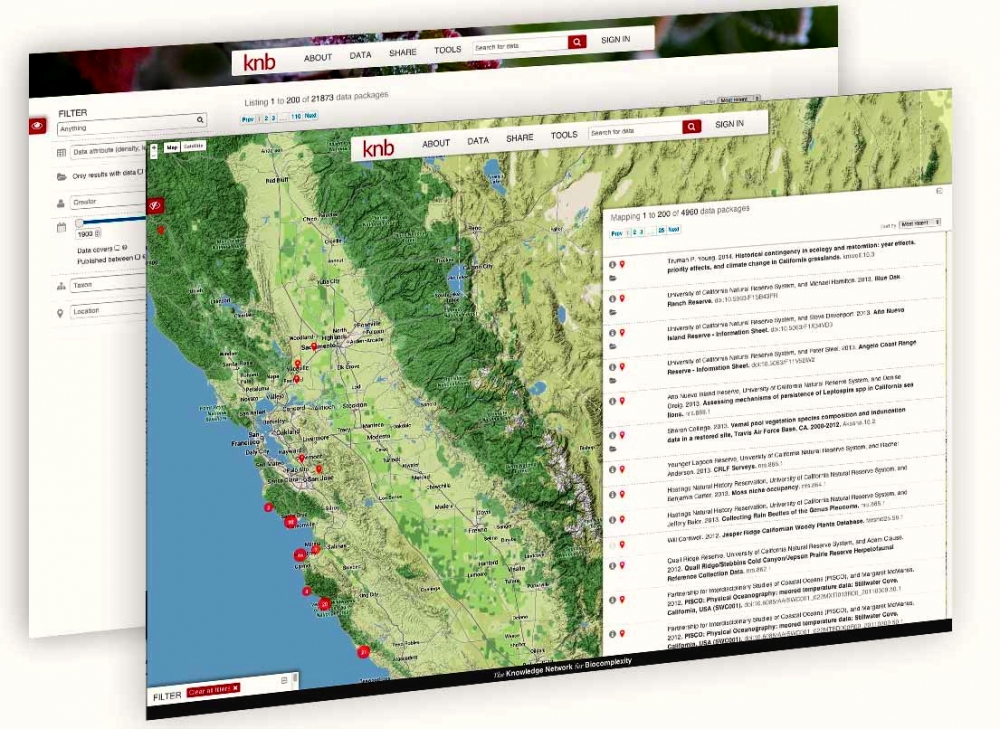1998
Type of resources
Available actions
Topics
Keywords
Contact for the resource
Provided by
Years
Formats
Representation types
Update frequencies
status
Scale
Resolution
-

The Knowledge Network for Biocomplexity (KNB) is an international repository intended to facilitate ecological and environmental research. The KNB was launched in 1998 with a grant from the National Science Foundation (NSF), with the purpose of being the long term home for synthesis datasets and research products generated by National Center for Ecological Analysis and Synthesis (NCEAS) working groups. Since then, NCEAS has continued to operate the KNB not only as an archive for NCEAS working group products, but also for the broader ecology and environmental science community. The KNB acceps all environmental or ecological related data and publishes datasets with Digital Object Identifiers for the express purpose of ensuring long-term access to these datasets. We strive to abide by FAIR (findable, accessible, interoperable, resuble) principles of data sharing and preservation. For scientists, the KNB is an efficient way to share, discover, access and interpret complex ecological data. Due to rich contextual information provided with KNB data, scientists are able to integrate and analyze data with less effort. The data originate from a highly-distributed set of field stations, laboratories, research sites, and individual researchers. The foundation of the KNB is the rich, detailed metadata provided by researchers that collect data, which promotes both automated and manual integration of data into new projects.
-

Ensemble des points d'eau naturels à vocation opérationnelle (sécurité civile) sur étangs, lacs, mares, ruisseaux, canaux, rivières et cours d'eau, localisés sur le département des Landes. Ces ressources sont classées selon le type alimentation en eau et le sous-type point d'eau. Date de Publication : 2009
-
Points de repère utilisés sur le terrain par l'ONF.
-

Ensemble de points d'eau artificiels enterrés ou semi-enterrés, qualifié en fonction de leur contenance et de leur type de réapprovisionnement sur le département du Lot-et-Garonne. Ils sont utilisés dans la défense extérieure incendie. Date de Publication : 2009
-

Acquisition de données topographiques de la plage intertidale du Truc Vert, côte atlantique à environ 20 km de la pointe du Cap Ferret. L'ensemble des données regroupent: -profils crossshore (perpendiculaire à la côte) en 2D réalisé au théodolite, s'étendant de la dune au bas de plage -levés au GPS cinématique en 3D sur 350m longshore par 250m crossshore -relevés au GPS métrique de la ligne de basse mer
-

Ensemble des ouvrages aménagés sur le réseau hydrographique, fossé et cours d'eau, en vue d'en permettre le franchissement tout en assurant le libre écoulement des eaux. Ces structures permettent le raccordement de pistes de DFCI et l'accès aux parcelles, permettant aux véhicules de secours et d'exploitation forestière de pouvoir manœuvrer. Ces données concernent les territoires forestiers des communes du Lot-et-Garonne appartenant à une association syndicale autorisée de Défense des Forêts contre l'Incendie. Date de Publication : 2009
-

Limites géographiques des secteurs de premier appel. Date de Publication : 2009
-

Ensemble des dispositifs de lutte contre l'incendie. Il s'agit d'un réseau souterrain d'eau sous pression permettant d'alimenter les fourgons d'incendie des sapeurs-pompiers. Ces réseaux sont dédiés à la défense extérieure contre l'incendie. Date de Publication : 2009
-
Réalisation d'une tache urbaine 1996 dans la cadre du SCOT Bordeaux
-

Subdivisions territoriales du Service Départemental d'Incendie et de Secours de la Gironde. Date de Publication : 2009
 Catalogue PIGMA
Catalogue PIGMA